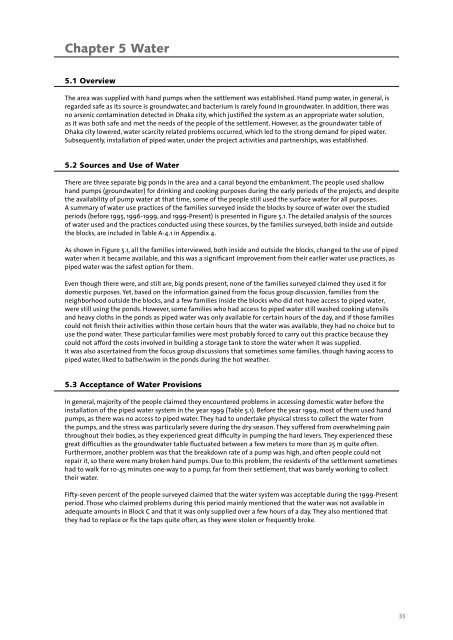Untitled - UNU-IAS - United Nations University
Untitled - UNU-IAS - United Nations University
Untitled - UNU-IAS - United Nations University
You also want an ePaper? Increase the reach of your titles
YUMPU automatically turns print PDFs into web optimized ePapers that Google loves.
Chapter 5 Water<br />
5.1 Overview<br />
The area was supplied with hand pumps when the settlement was established. Hand pump water, in general, is<br />
regarded safe as its source is groundwater, and bacterium is rarely found in groundwater. In addition, there was<br />
no arsenic contamination detected in Dhaka city, which justified the system as an appropriate water solution,<br />
as it was both safe and met the needs of the people of the settlement. However, as the groundwater table of<br />
Dhaka city lowered, water scarcity related problems occurred, which led to the strong demand for piped water.<br />
Subsequently, installation of piped water, under the project activities and partnerships, was established.<br />
5.2 Sources and Use of Water<br />
There are three separate big ponds in the area and a canal beyond the embankment. The people used shallow<br />
hand pumps (groundwater) for drinking and cooking purposes during the early periods of the projects, and despite<br />
the availability of pump water at that time, some of the people still used the surface water for all purposes.<br />
A summary of water use practices of the families surveyed inside the blocks by source of water over the studied<br />
periods (before 1995, 1996-1999, and 1999-Present) is presented in Figure 5.1. The detailed analysis of the sources<br />
of water used and the practices conducted using these sources, by the families surveyed, both inside and outside<br />
the blocks, are included in Table A-4.1 in Appendix 4.<br />
As shown in Figure 5.1, all the families interviewed, both inside and outside the blocks, changed to the use of piped<br />
water when it became available, and this was a significant improvement from their earlier water use practices, as<br />
piped water was the safest option for them.<br />
Even though there were, and still are, big ponds present, none of the families surveyed claimed they used it for<br />
domestic purposes. Yet, based on the information gained from the focus group discussion, families from the<br />
neighborhood outside the blocks, and a few families inside the blocks who did not have access to piped water,<br />
were still using the ponds. However, some families who had access to piped water still washed cooking utensils<br />
and heavy cloths in the ponds as piped water was only available for certain hours of the day, and if those families<br />
could not finish their activities within those certain hours that the water was available, they had no choice but to<br />
use the pond water. These particular families were most probably forced to carry out this practice because they<br />
could not afford the costs involved in building a storage tank to store the water when it was supplied.<br />
It was also ascertained from the focus group discussions that sometimes some families, though having access to<br />
piped water, liked to bathe/swim in the ponds during the hot weather.<br />
5.3 Acceptance of Water Provisions<br />
In general, majority of the people claimed they encountered problems in accessing domestic water before the<br />
installation of the piped water system in the year 1999 (Table 5.1). Before the year 1999, most of them used hand<br />
pumps, as there was no access to piped water. They had to undertake physical stress to collect the water from<br />
the pumps, and the stress was particularly severe during the dry season. They suffered from overwhelming pain<br />
throughout their bodies, as they experienced great difficulty in pumping the hard levers. They experienced these<br />
great difficulties as the groundwater table fluctuated between a few meters to more than 25 m quite often.<br />
Furthermore, another problem was that the breakdown rate of a pump was high, and often people could not<br />
repair it, so there were many broken hand pumps. Due to this problem, the residents of the settlement sometimes<br />
had to walk for 10-45 minutes one-way to a pump, far from their settlement, that was barely working to collect<br />
their water.<br />
Fifty-seven percent of the people surveyed claimed that the water system was acceptable during the 1999-Present<br />
period. Those who claimed problems during this period mainly mentioned that the water was not available in<br />
adequate amounts in Block C and that it was only supplied over a few hours of a day. They also mentioned that<br />
they had to replace or fix the taps quite often, as they were stolen or frequently broke.<br />
33
















